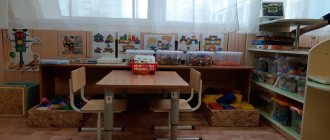Features of a child with ODD level I, ODD level II. Alalia (organization of RPPS, working methods)
Author: Tatyana Aleksandrovna Korekova , Category: Consultations for teachers · 2/2/2018 12:57:00
Good afternoon, dear teachers. At the first meeting, Olga Valerievna talked about children with disabilities and disabilities. The group of children with disabilities is not homogeneous; it includes children with various developmental disorders, the severity of which may vary. Let us remember what developmental disorders such children have.
Read all »
The little people method for solving adult problems
1 vote
Good day everyone! Do you remember, dear adults, how as a child your parents and teachers explained problems to you using apples, candies, toy trains and stuffed animals?
You will be surprised, but after many years, many things have remained unchanged in the fundamental principles of pedagogy. This also applies to the well-known “on your fingers” approach. The little people method also falls into this category of “explainers.” And, despite the seeming childishness, this technique works just fine.
What are we even talking about?
Let's start with the fact that the little men technique (LMT) appeared within the framework of the theory of solving inventive problems thanks to the founding father of TRIZ, Heinrich Altshuller. The scientist decided that with the help of funny little people, it would be easier for both the youngest and older inventors to understand the essence of various phenomena occurring at the micro level.
It is worth noting that Altshuller was not alone in this sense, because A similar principle had been applied long before by the famous British physicist Maxwell. A mature and really very smart scientist (that’s me in case you suddenly began to doubt this) represented various physical processes in the form of the corresponding actions of funny gnomes.
This way he was able to find competent solutions to problems faster than if he had used only dry formulas and calculations. In addition, with this approach, Maxwell, quite possibly, simply found a way for himself to perceive complex and serious science as an exciting, funny game.
And if you are not too lazy to delve into history a little more, you will find out that the principle of simplifying the conditions of problems by presenting certain complex systems in the form of the simplest and most understandable things has been used by many researchers. So, why don’t we follow their example?!
How it works?
The essence of MMC is to replace certain complex systems with groups of people acting in a specific way - in accordance with the properties of a given system. For example, if we talk about different states of matter, they can be expressed as follows:
- Solid. This is a group of little people who stand close to each other and hold hands tightly.
- Liquid. This is a group of little people who always stand close to each other, but do not hold hands.
- Gaseous. The little people are quite far from each other and are not holding hands.
As a result, it becomes clear that the first group will only move as a whole. Otherwise, you will have to figure out a way to separate the friendly people. But with the third group this will not be a problem; here you will still have to try to gather all the little people into one pile, because they are always trying to scatter to the sides.
This method of associative thinking works great for preschoolers who are just learning to solve their first “adult” problems, and for schoolchildren who are already quite old.
Moreover, in the case of the same states of matter, the children can be asked to take on the role of little men and, depending on the situation, try to act in one way or another. This way, children will understand the basic principles of the MMC method in the form of a very simple and visual fun game.
Due to its simplicity and effectiveness, the technique is actively used not only by teachers in preschool educational institutions and schools, but also by parents themselves during educational games at home.
Examples of solving problems with MMC
The principle of using little men includes three stages:
- Find out what exactly causes a certain contradiction or difficulty in the system.
- Understand exactly which element of the system experiences contradictions in relation to its physical (or, perhaps, chemical) state when certain ideality requirements are imposed on it. That is, which element is not able to become ideal due to objective reasons.
- Depict this element as a group of little people or launch a “quick response group” into it in the form of the same tiny helpers. In this case, there can be as many people as desired. And they can do absolutely whatever your heart desires! Any whim will be fulfilled in the blink of an eye. It is fundamentally important not to think about how these nimble kids will carry out your next order. Focus on what (!) exactly they will do in order to cope with the task and eliminate the very contradictions that prevent you from sleeping peacefully. Having found out this, you can already choose a competent solution to the problem, acting by analogy with what the little men did.
As a hint, we can add that in most cases, in order to eliminate some kind of contradiction, it is necessary to change in one way or another those elements that come into contact with the operational zone.
Problem
In spring and autumn, when the weather outside has not yet settled and the temperature jumps back and forth, utility workers face one serious difficulty. The snow that accumulates in the upper part of the gutters melts and freezes again many times, forming ice plugs inside the pipes.
Then, with the next warming, these plugs melt and with all their impressive mass they rush down the pipe with a roar, tearing off the lower parts of the structure. As a result, drainpipes have to be repaired very often.
Middle school children were asked to come up with a solution to this problem. To do this, it was first necessary to determine the operational zone - that is, the one in which the problem arises. As already noted, it becomes the upper part of the pipe in which snow accumulates.
Then it was necessary to identify the cause of the problem - the formation of ice plugs. In conclusion, it was proposed to formulate the ideal end result - the cork does not fall down the pipe until it has completely melted.
After thinking, the guys decide that this would be possible if the plug were somehow held on to the walls of the pipe themselves. But in this case, as soon as it starts to melt, it will fall. Which means she can’t melt. A contradiction arises - you need to melt, but you can’t.
Schoolchildren call little people for help, launching them into the source of the problem - a traffic jam. Here they are trying to hold back a heavy piece of ice rushing down. To do this, the little men join hands in a chain. The top ones grab the top of the pipe to hold their comrades on themselves. And the lower ones wrap around the cork itself.
The students carefully draw this entire composition and, looking at the finished picture, give the answer - “We need to put something strong into the pipe that could hold ice on it. For example, wire. The ice will freeze around it, and as it thaws, it will slowly flow down. And so on until the entire traffic jam “dissolves.” Great, a solution has been found, bravo!
**
Special books on TRIZ will help you develop this kind of thinking. For children, we can recommend the bright and interesting series of books “The Newest Adventures of Kolobok” . And adults will learn a huge amount of new and useful things from Yuri Salamatov’s book “How to Become an Inventor” and his TRIZ training .
I hope that I have inspired you enough to learn a new technique. If you have questions, ask them in the comments to the article. I will definitely answer everyone. That's all, see you next time! Yours, Yuri Okunev.
Description of the method:
(based on the manual Mikhailov V.A., P.R. Amnuel. Development of creative imagination Methodological instructions for the workshop. Cheboksary, 1980):
The essence of the little people modeling method (LMM) is to present the task object or conflict zone (operational zone) in the form of a large number (“crowd”) of little people and invite them to fulfill conflicting (ideal) demands. Little people will show us how to rebuild the system.
Having reduced the conflicting requirements to a small zone, the solver finds himself in a quandary - he does not know the laws and rules by which this zone can be transformed. But he does not have knowledge or developed thinking in this area. Having ordered the little men to rearrange themselves in such a way as to eliminate the contradiction, the solver does not suffer from an attack of psychological inertia, but freely commands in a certain playing area. And, having received the necessary structure, it looks for whether there is something similar in reality.
This approach is close to empathy - identifying oneself with a changeable object, but is also different from it. Using empathy, the inventor retains actions that are acceptable to humans and discards unacceptable ones, such as crushing.
MMMCH preserves the clarity and simplicity of empathy and eliminates the indivisibility of the organism. An object, represented in the form of a crowd of people, retains all its properties, but at the same time can change at our command in the way we need.
Also, people are better than balls or atoms. Atoms obey the laws of physics, little men obey us. In addition, little people can see, understand, and act on their own. They can be given freedom to act “humanly” by following our orders. They can be given goals of different ranks and watch how they achieve them.
Little people themselves or with our help make up a consistent picture. This will be the structure of the solution to our problem, which can easily be associated (recall) with a well-known technical solution.
MMMCH operations:
a) depict the selected part of the object, which does not fulfill the requirements of the ideal final result, as a collection of little people; b) divide people into groups acting according to given functions and requirements; c) provide the little people with the opportunity to resolve the conflict themselves and fulfill conflicting demands; d) evaluate the reconstruction made by the little men.
In tasks for measuring MMMP, it is advisable to carry out it in the following order: a) place little people on that part of the object that is to be measured (along a line, along an area, by volume); b) consider the possible actions of these little men; c) if there is no solution, rearrange the little men, arranging them intermittently; d) if there is no solution, rearrange the men again, arranging them in a triangle - with straight and curved sides; e) each time you need to remove extra people: a triangle, for example, can be obtained with only three people, a square - with four, etc.
The MMC method plays a supporting role. It is advisable to use it in cases where there is no prototype and you need to build some kind of reference model for analysis. It allows you to get rid of the psychological inertia of the indivisibility of the object of analysis and creates a structure that evokes the image of a solution in memory.
Instructions
Operating procedure for MMC
1. Describe the problem and highlight an element - an object for change.
2. Formulate conflicting requirements (ICR) for the object.
3. Imagine the object as a crowd of little people.
4. Divide the little men into different groups, each performing one function or reflecting one or another property of the object.
5. Rebuild the model (give the little men a command) so that the necessary actions are performed and there are no conflicts between different groups of little men.
6. Look for a technical solution.
Templates:
An example is a problem about a dispenser (based on the book by V. Petrov Basic course in the theory of solving inventive problems. Textbook. Tel Aviv, 2002, link https://triz.natm.ru/articles/petrov/00.htm):
The liquid dispenser is designed in the form of a scale cup.
When there is enough liquid, the dispenser tilts to the left and everything pours out. After pouring, the dispenser tilts to the right.
But as soon as the liquid begins to drain, the left side becomes lighter, the dispenser returns to its original position earlier than necessary. “Underfilling” is uncontrollable, the dispenser is inaccurate.
How to eliminate the shortcoming while maintaining this simple design?
Let's imagine the dispenser in the form of a crowd of little people. Let's divide the crowd into water men (girls) and cargo men (boys).
It is clear that the boys are not waiting for the girls to jump off. That's why conflict arises. And in order for it not to happen, the boys must wait for the girls, let’s say like this:
Technically it looks like this:
The conflict has been resolved.
Description of the idea generation technique
Description of the methodology for generating ideas.
The Little Men Method.
Little Men Method
— fragmentation of a problem situation into many “little people.”
The little men method was developed by G.S. Altshuller for solving inventive problems.
This method allows us to better understand the physical processes and phenomena occurring at the micro level. The little men method is that all molecules are depicted in the form of little men, which differ in their state of aggregation. (see Fig. 1, 2, 3)
Fig. 1 The molecules of a solid are represented by little men standing close and holding hands.
Fig. 2 Liquid molecules with little men who stand close, but do not hold hands.
Fig. 3 Gas molecules with little men who are far from each other and do not hold hands
In his method of creative search - synectics, W. Gordon proposed a technique called empathy, which consists in the fact that the inventor imagines himself as a machine part and thinks what he needs to do to complete the task. This method has the disadvantage that a person has a very specific shape, which does not always correspond to the optimal shape of the part, which makes it much more difficult to find a solution.
G.S. Altshuller, in his theory of inventive problem solving (TRIZ), proposed modeling with little people (LMM), which is a further development of Gordon’s empathy, but overcomes this contradiction, because in the MMC, a part is represented as many little people who together can give any shape, which significantly expands the search possibilities. However, little people remain little people, which means they do not have many properties available to technical objects, such as levitation - hovering in the air or electromagnetic fields, telekinesis using an electromagnetic field, ultrasound, etc.
Using this method, it is easier to imagine a model of a system or process. Replacing the elements located in the zone where the task arises with living beings liberates thinking, makes it freer and makes it possible, at least mentally, to perform the most fantastic actions. Intuitively, this method has been used by many researchers and scientists.
When solving many problems, the famous physicist Maxwell imagined the process under study in the form of little gnomes who could do everything that was necessary. Such gnomes in literature are called “Maxwell’s gnomes.” Maxwell, constructing his experiment during the development of the dynamic theory of gases. mentally placed him in interconnected vessels with demon gases. These demons opened the door for hot, fast particles of gas and closed it in front of cooled, slow ones.
Kekule saw the structural formula of benzene as a ring formed from a group of monkeys. who grabbed each other. The outstanding Russian aircraft engine designer Mikulin recalled: “Once I listened to the opera “The Queen of Spades.” When Herman raised the pistol, I suddenly saw in the bend of the hand with the pistol a shaft with a compressor, and then it was clear: what I was looking for was a radiator. I immediately jumped out of the box and sketched out a diagram on the program..."
An imaginative style of thinking is inherent in all people of creative professions. But not every image is effective. For example, a simple graphic representation of a part is also visual, but it has a drawback - it ties us to the prototype. Little people do not remind us of anything known, but they show the picture in full, and therefore we are free in our mental activity. For some, the process of drawing little people may seem too childish, frivolous, and unscientific. This opinion is wrong. The method affects the deepest and most intimate processes of thinking, evoking vivid images and associations, leading away from stereotypes and habitual actions.
Purpose of MMC
— increase the efficiency of the search for ideas, using not only the psychological activation of creative thinking, but also the heuristic (search) mechanism for solving the problem. Facilitate the work on the algorithm for solving inventive problems.
The method is used when difficulties arise in implementing the chosen principle of resolving a physical contradiction.
Where to start when using the little people modeling method?
First:
identify the operational zone of the task, i.e. the place where the physical contradiction arose.
Second:
identify an element that experiences conflicting demands on its physical state when demands for ideality are placed on it.
Third
: Launch little people into this element or depict it as a crowd of little people.
There should be two drawings - the original state and the required one. When drawing little people, do not waste your pencil and time. There should be a lot of people, and remember that they can do everything (!), even the most fantastic, the most incredible. For them there is nothing impossible, there are no prohibitions, they are omnipotent and fulfill your every desire. There is no need to think about how
they will do it yet, it is important to find out
what
they should do. Later, according to your knowledge, you will find a way to achieve what the little men showed. Most often you have to change elements adjacent to the operational zone, but you already know how to do it, because the little people helped you with this.
Now let's look at the work of little people using a small example.
In the autumn-spring periods, housing and communal services workers have more work to do to repair drainpipes. The fact is that during these periods, snow accumulates in the upper part of the drainpipes, which, repeatedly thawing and freezing, turns into ice plugs. During the next warming, this ice plug melts and falls like a bomb down the pipe, breaking and crushing it. You have probably seen the broken ends of drainpipes more than once.
N
We find the operational zone, that is, the beginning of the problem - the upper part of the pipe. We find the element that is causing the problem - an ice plug.
Compiling the IFR - The ice plug itself does not fall down until it completely melts. This is possible if the ice is held by the pipe walls. but in this case he cannot... melt.
A physical contradiction has arisen: - ice should melt and should not melt... What to do?
We launch little people into an ice jam, like on a battlefield.
There are many of them, they cling to each other and try their best to hold the cork, not letting it fall until it melts completely.
The eighth-graders, who “drew” this problem and admired the little men, exclaimed: “We need to replace the little men with a chain or, even simpler, with wire. The ice plug will remain on this wire until it melts completely!”
That's it, problem solved! And it seems not bad. Implementing this solution will not be difficult. The cost is equal to the cost of two meters of wire. The solution the guys found should have been filed as an invention application. But the patent search only confirmed that Stanislaw Lem was right, who said: “The Universe is so big that there is nothing in it that does not exist.” Indeed, just a year earlier, adult inventors working at the Research Institute of Public Utilities proposed a similar solution. But even in this case, it was worth thanking the little people for the big hint.






